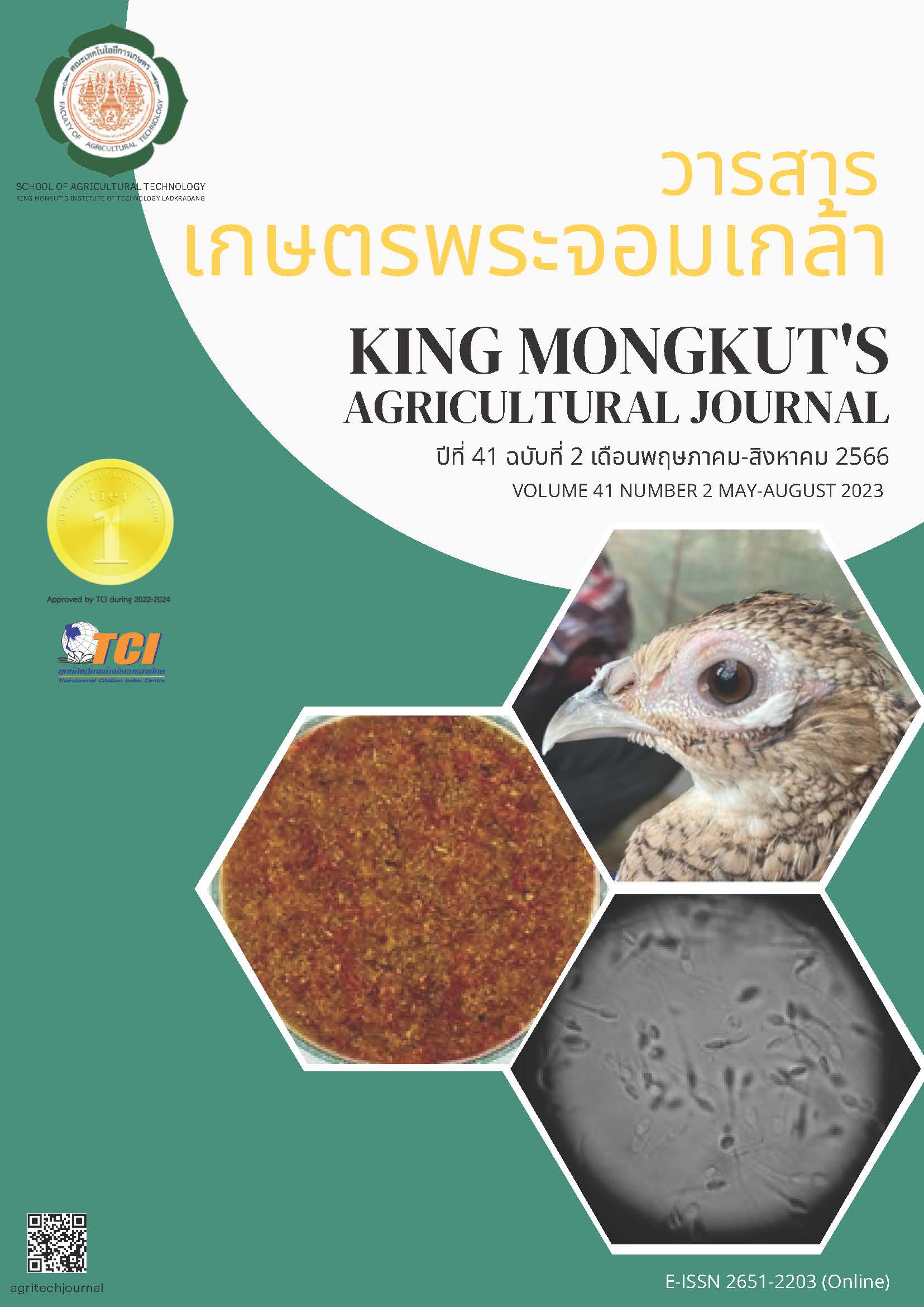การศึกษาพฤติกรรมของเสือโคร่งขาวเพศเมียในสภาพกรงเลี้ยงที่แตกต่างกันของเชียงใหม่ไนท์ซาฟารี
Main Article Content
บทคัดย่อ
เสือโคร่งขาว เป็นเสือโคร่งที่มีสีขนเป็นสีขาวซึ่งเกิดจากความผิดปกติของเม็ดสีมักพบในเสือโคร่งเบงกอลที่เกิดจากความผิดปกติของยีน เสือโคร่งขาวจัดอยู่ในกลุ่มสัตว์ที่ใกล้สูญพันธุ์ (IUCN) จึงมีความสำคัญต่อการอนุรักษ์ ในการศึกษาครั้งนี้มีวัตถุประสงค์เพื่อศึกษาพฤติกรรมของเสือโคร่งขาวเพศเมียในสภาพกรงเลี้ยงที่แตกต่างกันโดยทำการศึกษาในเสือโคร่งขาวเพศเมียจำนวน 7 ตัว แบ่งกลุ่มการทดลองออกเป็น 3 กลุ่ม ได้แก่ กรงเลี้ยงแบบขังเดี่ยว กรงเลี้ยงแบบขังรวมกัน และ กรงเลี้ยงแบบขังรวมกันร่วมกับเสือชนิดอื่น ทำการสังเกตและบันทึกพฤติกรรม โดยแบ่งเป็น 5 กลุ่มพฤติกรรม ได้แก่ กิจวัตรประจำวัน การเคลื่อนไหว การผ่อนคลาย การดูแลตัวเอง และ พฤติกรรมร่วม เป็นเวลา 7 ชั่วโมง/วัน เป็นระยะเวลาการศึกษา 90 วัน ผลการศึกษาพบว่า กรงเลี้ยงแบบขังเดี่ยวมีการดูแลตัวเองและการผ่อนคลายมากกว่ากรงเลี้ยงแบบขังรวมกันและกรงเลี้ยงแบบขังรวมกันร่วมกับเสือชนิดอื่น อย่างมีนัยสำคัญทางสถิติ (P<0.001) กรงเลี้ยงแบบขังรวมกันมีกิจวัตรประจำวันและการเคลื่อนไหวมากกว่ากรงเลี้ยงแบบขังเดี่ยวและกรงเลี้ยงแบบขังรวมกันร่วมกับเสือชนิดอื่น อย่างมีนัยสำคัญทางสถิติ (P<0.001) กรงเลี้ยงแบบขังรวมกันร่วมกับเสือชนิดอื่นมีพฤติกรรมร่วมมากกว่ากรงเลี้ยงแบบขังเดี่ยวและกรงเลี้ยงแบบขังรวมกัน อย่างมีนัยสำคัญทางสถิติ (P<0.001) ผลการศึกษาในครั้งนี้ใช้เป็นแนวทางในการเสริมสร้างพฤติกรรมและการออกแบบส่วนแสดงที่เหมาะสมต่อเสือโคร่งขาว
Article Details

อนุญาตภายใต้เงื่อนไข Creative Commons Attribution-NonCommercial-NoDerivatives 4.0 International License.
วารสารเกษตรพระจอมเกล้า
เอกสารอ้างอิง
Carlstead, K. & Shepherdson, D. (1994). Effects of environmental enrichment on reproduction. Journal of Zoo Biology. 13(5), 447-458.
Carlstead, K. (1996). Effects of captivity on the behavior of wild animals. Wild Mammals in Captivity. Chicago: University of Chicago Press.
Clubb, R. & Mason, G. J. (2001). Are some carnivore species predisposed to develop stereotypy because of their foraging strategy in the wild. In Proceedings of the Fourth International Conference on Environmental Enrichment: The Shape of Enrichment. (pp. 139-141). San Diego: Notion Press.
Cristina, B., Paola, M., Daniela, D., Francesca, P., Martina, T., Maria, S. G., Cristiana, M. & Pier, L. A. (2016). Behavioural analysis of captive tigers (Panthera tigris): A water poolmakes the difference. Applied Animal Behaviour Science. 174, 173-180.
Dawkins, M. S. (2004). Using behaviour to assess animal welfare. Animal Welfare. 13(1), S3-S7.
IUCN, (2008). IUCN Red List of Threatened Species. Retrieved from: www.iucnredlist.org
Jenny, S. & Schmid, H. (2002). Effect of feeding boxes on the behavior of stereotyping amur tigers (Panthera tigris altaica) in the Zurich Zoo, Zurich, Switzerland. Journal of Zoo Biology. 21(6), 573-584.
Lisa, M. K., Chair, L. S. G. & Marcella, J. K. (2003). Wild Tiger in Captivity: A Study of the Effect of the Captive Environment on Tiger Behavior. Master’s thesis. Virginia Polytechnic Institute and State University.
Markowitz, H., Aday, C. & Gavazzi, A. (1995). Effectiveness of acoustic “prey”: environmental enrichment for a captive African leopard (Panthera pardus). Journal of Zoo Biology. 14(4), 371-379.
Martin, P. & Bateson, P. (2007). Measuring Behaviour. 3rd ed. Cambridge: Cambridge University.
Mohapatra, R. K., Mishra, A. K., Parida, S. P. & Mishra, S. (2010). Behavioural responses to environmental enrichment in captive tigers (Panthera tigris) at Nandankanan Zoological Park, Orissa. Journal of Organisation for Protection of Ecosystem, Environment and Endangered Species. 8(2), 44-48.
Mohapatra, R. K., Sudarsan, P. & Usa R. A. (2014). Study on activity pattern and incidence of stereotypic behavior in captive tigers. Journal of veterinary behavior. 9(4), 172-176.
Shepherdson, D. J., Carlstead, K., Mellen, J. D. & Seidenstricker, J. (1993). The influence of food presentation on the behavior of small cats in confined environments. Journal of Zoo Biology. 12(2), 203-216.
Steel, R. G. & Torrie, J. H. (1980). Principles and procedures of statistics. New York: McGraw Hill Book.
Xiao, X., Gui, X. D., Xue, S. H., Lin, M., Xue, L. Z., De, L. Z., Han, D. Y., Tian, Y. Z., Zheng, T. Z., Ting, T. Z., Yan, Z., Jong, B., Yun, S.C., Wen, T. D., Tai, J. J., Can, X., Ruiqiang, L. & Shu, J. L. (2013). The Genetic Basis of White Tigers. Current Biology. 23(11), 1031-1035. Retrieved from http://dx.doi.org/10.1016/j.cub.2013.04.054.
Young, R. J. (2003). Environmental Enrichment for Captive Animals. Victoria: Blackwell Science. Ltd.


